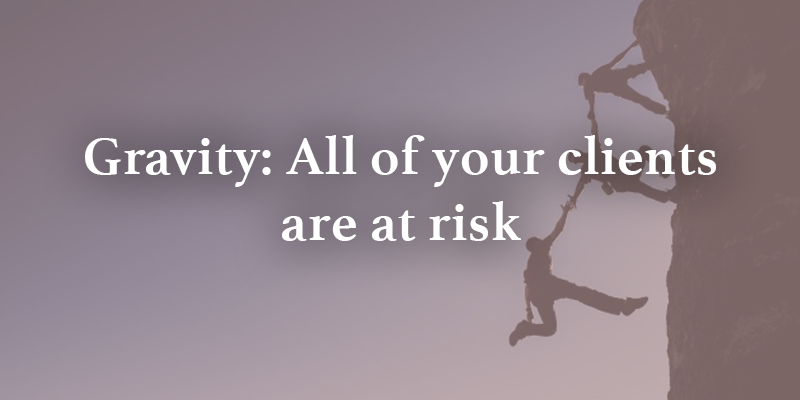As the name of my blog implies, my life is a strange combination of geekiness about Customer Success and nerdiness about science. On the latter in particular, I’m passionate about the mysteries that physics reveals about the universe around us.
And if you’re a casual student of physics like me, you know that nothing is more mysterious and permanent in the history of the science than gravity.
Gravity weaves its way through much of physics history from Galileo’s object dropping experiment to Newton’s (somewhat theorapocryphal) falling apple to Einstein’s Theory of General Relativity in 1915—and even to the recent discovery of Gravitational Waves last year, validating Einstein’s theories.
Just as gravity is the permanent background behind our evolving understanding of the universe, another kind of gravity is the showing up in the business world.
With customers getting ever more power in business relationships through low commitment pricing models (e.g., month-to-month or utility pricing) and low friction switching costs (e.g., cloud), an irresistible force is dragging on your client base.
If you’ve been in business a while, you may have noticed the switch. Your clients used to stay with you through thick and thin—and perhaps an occasional steak dinner or sporting event. They didn’t have many choices. It was a pain for them to leave. They were locked in contractually. And they didn’t even know much about other options.
Now, you’re re-earning their business every day.
If you follow my writing or my company’s blogs, this is motherhood and apple pie—this is the heart of Customer Success.
But the next level implication is where it gets interesting.
Today, one of the key questions CEOs, Sales Leaders, and Customer Success Leaders like to ask is, “Which of my clients are at risk?” Indeed, our software at Gainsight is partially designed to give you a quantitative and methodical framework to answer this question.
Which of my clients are red? Who’s yellow? And who’s green?
In the near-term (e.g., your next renewal cycle), clearly you have some distribution. Some are doing great, some fine and some in trouble. Some are really wedded to your product or service and locked in. Some could switch in a heartbeat.
But here’s the sobering reality:
In the long run, all of your clients are red. They are all at risk:
- Your sponsor at the client will leave and the replacement may have experience with a competitor.
- The client could have a bad experience with your team that changes everything.
- Your customer could switch business strategies and have less of a need for your offering.
- Your competitors could evolve faster than you are and be relatively more compelling in a year or two.
As my colleague Dan Steinman likes to say, “the natural tendency of clients is toward churn.”
Churn is the silent force—like gravity—pulling on your clients and, in result, on your business.
And while this happens in the “micro” level (client by client), it happens at the “macro” level as well. I meet CEOs frequently who pride themselves on their “90-something percent retention rate.” Churn doesn’t affect them. They’re out in space where gravity can’t touch them.
Until it does. What I’ve found is changes in churn rate (like gravity) accelerate over time. A solution is sticky and is the leader, so most clients stay. Then the cracks appear and alternatives improve. The early churns look insignificant. But then they snowball. All of a sudden, 95% retention is 50% or worse.
So what do you do? I think fundamentally, leaders have to switch their thinking from assuming that clients are “acquired” and theirs to the idea that vendors re-earn their clients’ business every day. In the long run, this means prioritizing and budgeting investments to ensure long-term client retention and success—not just assuming it will happen.
Churn is like gravity. If something goes up, you need to fight hard to preventing it from coming down.
This is a hard fact to accept. Business is more of a treadmill than ever before. And if you don’t feel like you’re constantly running, it probably means you’re about to fall off the track.

